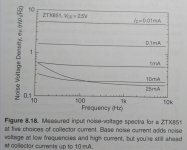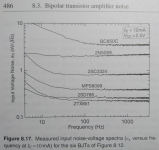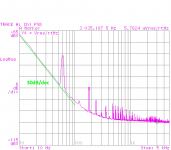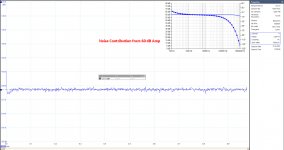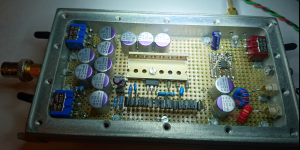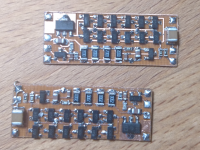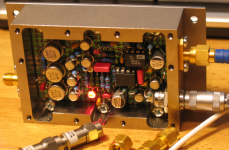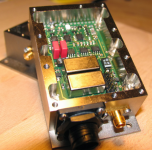1/f under 10Hz is outlandish. Again, I have never seen such a low value for any bipolar discrete device, even for the famous unobtanium discrete devices.
LT1028 is the lowest voltage noise corner frequency (claimed 3.5Hz typical) I've seen. But the current noise corner frequency is shown 250Hz (typical) in the data sheet. Ahem... I'm not buying the voltage number.
LT1028 is the lowest voltage noise corner frequency (claimed 3.5Hz typical) I've seen. But the current noise corner frequency is shown 250Hz (typical) in the data sheet. Ahem... I'm not buying the voltage number.
These are the measurements of Hill/Horrowitz Art Of Electronics III , page 486:
Attachments
Last edited:
For my application I venture to disagree your opinion on Nichicons in this type of application.To my experience, the Nichicon capacitors are excellent. See all the noise measurements I posted in this thread. Perhaps I was lucky or you had bad luck.
Indeed big difference. I don't understand your last noise measurement, I see no 1/f noise at all. That's a physical impossibility. Unless the noise corner frequency is much under 10Hz, which I would find very hard to believe. I have never seen a discrete bipolar with such a low corner noise frequency.
All 4 modules had at least +20dB elevated LF noise at 20Hz, but the upper half of the transimpedance amp was the worst of them all with +40dB@20Hz.
Now with the Alu caps there is no elevated LF noise at all, when measured through a second order HP filter that's:
-0.6dB@30Hz,
-2.3dB@20Hz
-10.9dB@10Hz
-22,6dB@5Hz
So the expected 1/f noise will most likely be masked by this filter. And remember that Wayne (#1507) also had no raised LF noise down to 20Hz.
Not meaning to offend, but the noise spectra you showed earlier in this thread also had the dreaded -30dB/dec LF noise with these Nichicon Polymers. See image below. With the current knowledge this is most likely not caused by the ZTX transistors but by the Nichicons, would be easy to try.
But one very positive thing came out of this exercise, all 20 ZTX851/951 that I have do perform equally, with a very low noise and an extremely low 1/f frequency.
What I have at the moment has all the properties for a test jig with 1.5V on the caps. For me that will do.P.S. You could easily set up a measurement jig for these caps, biased @3V. That's probably too much to ask, I'll do it myself when I'll have the time.
Hans
Attachments
These are the measurements of Hill/Horrowitz Art Of Electronics III , page 486:
So all voltage noise corner frequencies appear to be up well over 100Hz, that makes sense.
At 1mA, not even a trace of 1/f is visible for the 851 at 10 Hz.
The LT1028 has 5 mA tail current for the 2 inputs together, so its 5Hz claim is absolutely credible. And it may have even better beta, maybe even super-beta-ish thin bases. High Vce and Early voltage are not limiters here.
1/f is a poor concept. If you have enough white noise, you can move the 1/f corner arbitrarily low. E.Rubiola (rubiola.org) has a better metric.
The LT1028 has 5 mA tail current for the 2 inputs together, so its 5Hz claim is absolutely credible. And it may have even better beta, maybe even super-beta-ish thin bases. High Vce and Early voltage are not limiters here.
1/f is a poor concept. If you have enough white noise, you can move the 1/f corner arbitrarily low. E.Rubiola (rubiola.org) has a better metric.
Last edited:
For my application I venture to disagree your opinion on Nichicons in this type of application.
All 4 modules had at least +20dB elevated LF noise at 20Hz, but the upper half of the transimpedance amp was the worst of them all with +40dB@20Hz.
Now with the Alu caps there is no elevated LF noise at all, when measured through a second order HP filter that's:
-0.6dB@30Hz,
-2.3dB@20Hz
-10.9dB@10Hz
-22,6dB@5Hz
So the expected 1/f noise will most likely be masked by this filter.
I'm certainly missing something here, what filter are you taliking about? I see no filter in your schematics or measurement setup. Does this mean the noise with the Nichicon caps is actually even higher?
Last edited:
Thank you for the graphs. They conform very well with my flat spectrum measurement. At 3.1 mA, noise @10Hz is max 5dB above the flat level and some 2dB@20Hz. So this is indeed exactly masked by my HP filter.These are the measurements of Hill/Horrowitz Art Of Electronics III , page 486:
Hans
At 1mA, not even a trace of 1/f is visible for the 851 at 10 Hz.
The LT1028 has 5 mA tail current for the 2 inputs together, so it's 5Hz claim is absolutely credible. And it may have even better beta, maybe even super-beta-ish thin bases. High Vce and Early voltage are not limiters here.
Super beta-ish thin base means a large Rbb. Not good for noise.
Between the Head Amp and the oscilloscope, I use a 60dB amp with a second order HP filter. See image below, where the noise of this Amp is scaled down a factor 50, to make it 1:1 comparable with the input noise of the Head Amp with a Gain of 50.I'm certainly missing something here, what filter are you taliking about? I see no filter in your schematics.
As can be seen, noise level is 20dB below the noise RTI of the Head amp and can therefore be neglected.
Hans
.
Attachments
Ok, this explains the flat noise you got. I would still be curious of the corner noise frequency of the ZTX (or consistency, thereof).
Because you mentioned it, my 60dB preamp does not have any input filter, it is DC coupled, and being a JFET input has the corner noise frequency of about 500Hz (with some 17dB/decade, meaning it is 1/f plus some G-R noise). This explains a good chunk of the measurement noise at very low frequencies.
Because you mentioned it, my 60dB preamp does not have any input filter, it is DC coupled, and being a JFET input has the corner noise frequency of about 500Hz (with some 17dB/decade, meaning it is 1/f plus some G-R noise). This explains a good chunk of the measurement noise at very low frequencies.
Last edited:
Don't have polymer caps generally much higher leakage currents anyway? Many years ago I was told that polymers are, for this reason, the worst choice for filtering voltage references in regulators.
Super beta-ish thin base means a large Rbb. Not good for noise.
I did say superbeta-ish and not superbeta. You do not need to go to extremes to get a beta >> 200 and you can make up for it with area and more base contacts.
It has advantages if you can tailor your transistors in an ic.
One of the more interesting Rubiola articles for this audience is
< http://rubiola.org/pdf-articles/journal/2004rsi(rubiola)low-flicker-dc-amplifier.pdf >
I'm more a time/frequency nut.
/Gerhard
Ok, this explains the flat noise you got. I would still be curious of the corner noise frequency of the ZTX (or consistency, thereof).
OMG, it is in the left AOE-Plot, for 5 different collector currents.
OMG, it is in the left AOE-Plot, for 5 different collector currents.
OYG, my concern is not about the absolute value, but about the consistency. I got it bad (if you sifted through this thread) and I would like to find out what others get.
This is with one set of ZTX
This is with another set of ZTX, everything else being the same.
My results for the left picture and the right picture are identical and in line with the results of HH, who measured 100 parts of every type IIRC.
They also are in line with that what Hans has now with the non-defective capacitors.
The sot-23 version is probably the same chip, it's called zxt2018 or so, the SMD marking code is 851 which is probably not by coincidence. All circuits are derived from Art of Electronics 3 and behave like predicted by HH.
And the circuit by Enrico Rubiola is also in line with one I built 10 years earlier, after a PMI? app note, with a simpler current source, and more current for less flat noise at the expense of 1/f. sub-10Hz 1/f corners do exist, it's not witchcraft. Look at the MAT-02 date codes. OK, I let them sleep for quite some time, they were always too precious for what was to do right now.
Cheers, Gerhard
They also are in line with that what Hans has now with the non-defective capacitors.
The sot-23 version is probably the same chip, it's called zxt2018 or so, the SMD marking code is 851 which is probably not by coincidence. All circuits are derived from Art of Electronics 3 and behave like predicted by HH.
And the circuit by Enrico Rubiola is also in line with one I built 10 years earlier, after a PMI? app note, with a simpler current source, and more current for less flat noise at the expense of 1/f. sub-10Hz 1/f corners do exist, it's not witchcraft. Look at the MAT-02 date codes. OK, I let them sleep for quite some time, they were always too precious for what was to do right now.
Cheers, Gerhard
Attachments
gerhard, is it close to MM hiss levels? roughly 30db below record noise
Nice job on the Surface mount board.
Nice job on the Surface mount board.
Last edited:
And it also worked like promised with the SSM2220, used to keep cost down.
I don't really understand the question; it is quite close to that what can be done. It makes sense only with a very low impedance source. I think it would be a poor match for a moving magnet pickup. That one delivers much more voltage, so that such an amplifier would not be needed; and the amplifer would not see the environment it likes.
cheers, Gerhard
With these references, I don't see any results of transistor noise, only unrelated talk of some people. The page that starts at #1111 and the one at #1201.
cheers, Gerhard
gerhard, is it close to MM hiss levels? roughly 30db below record noise.
I don't really understand the question; it is quite close to that what can be done. It makes sense only with a very low impedance source. I think it would be a poor match for a moving magnet pickup. That one delivers much more voltage, so that such an amplifier would not be needed; and the amplifer would not see the environment it likes.
cheers, Gerhard
With these references, I don't see any results of transistor noise, only unrelated talk of some people. The page that starts at #1111 and the one at #1201.
cheers, Gerhard
Attachments
With these references, I don't see any results of transistor noise, only unrelated talk of some people. The page that starts at #1111 and the one at #1201.
I have no idea what you are talking about, must be late in Germany.
gerhard, I am referring to how much amplifier noise is present in the speakers at say 1 watt vs a low noise MM preamp.
this could also be stated as the difference between preamp noise and Record noise when the needle hits the lead in groove before the first track.
this could also be stated as the difference between preamp noise and Record noise when the needle hits the lead in groove before the first track.
Yes it is late, but the addresses you give point to unrelated stuff in nirvana.
They point specifically to #375 and #403
- Home
- Source & Line
- Analogue Source
- Richard Lee's Ultra low Noise MC Head Amp
